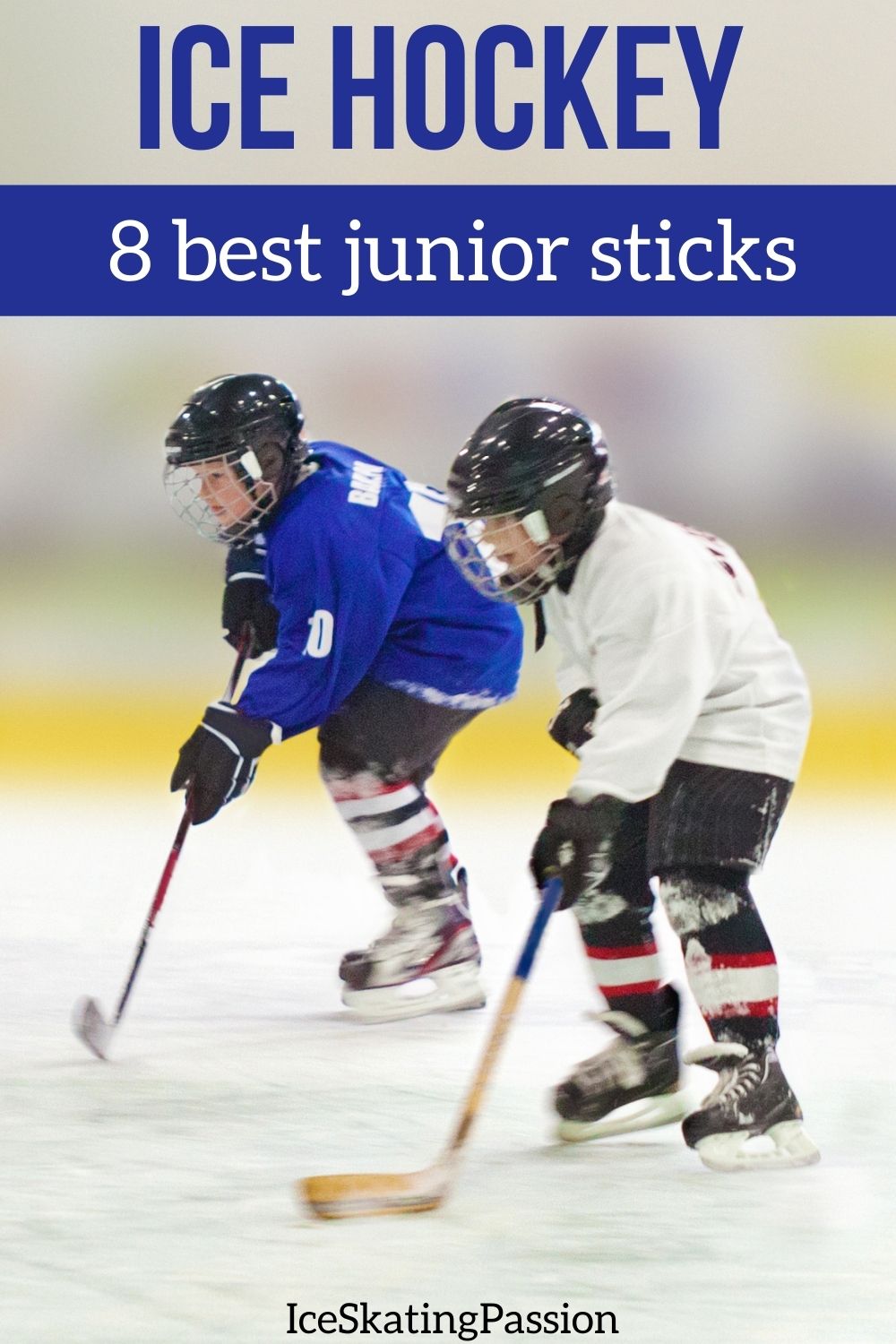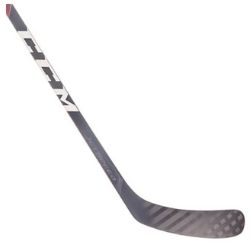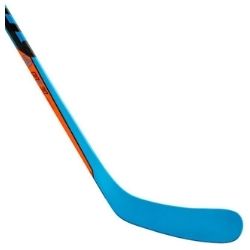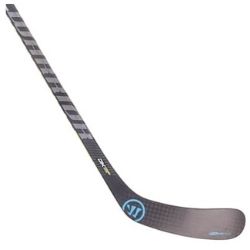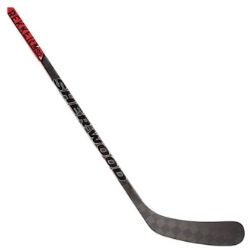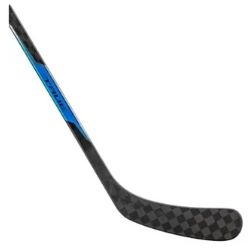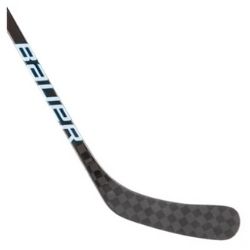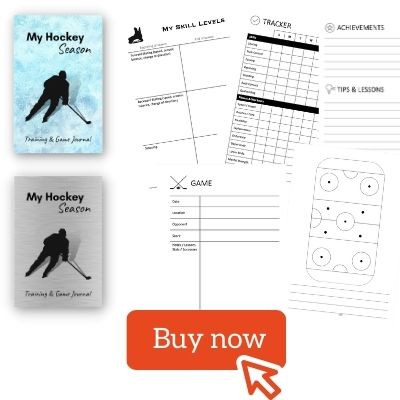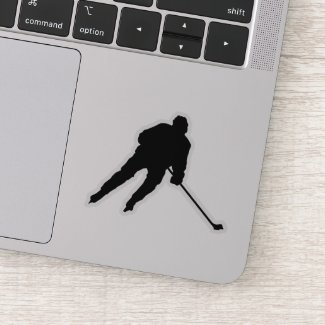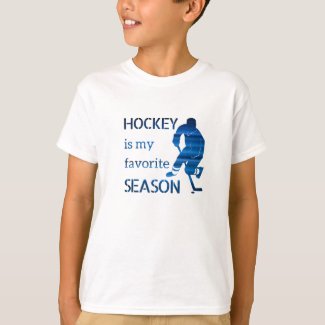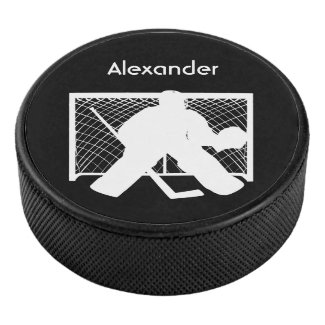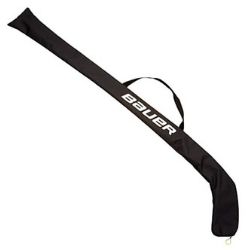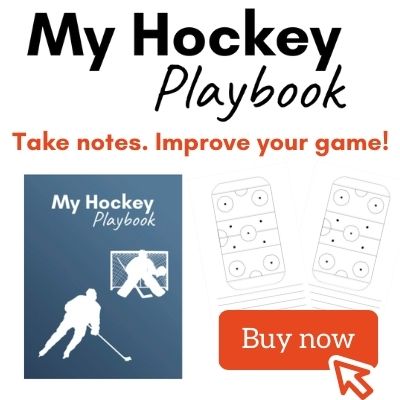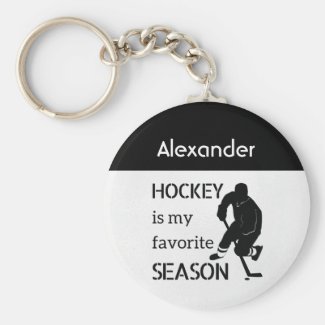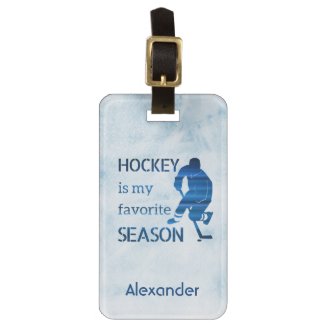Need an ice hockey stick for your junior hockey player?
Below is my guide to help you find the best junior hockey stick for your child with:
- Criteria to understand the differences and make a choice
- The 8 best current options (with reviews) based on price and level
- Tips to take care of the stick and make it last longer
- ...
Note: if your child is in youth, prefer my article about the best youth hockey sticks.
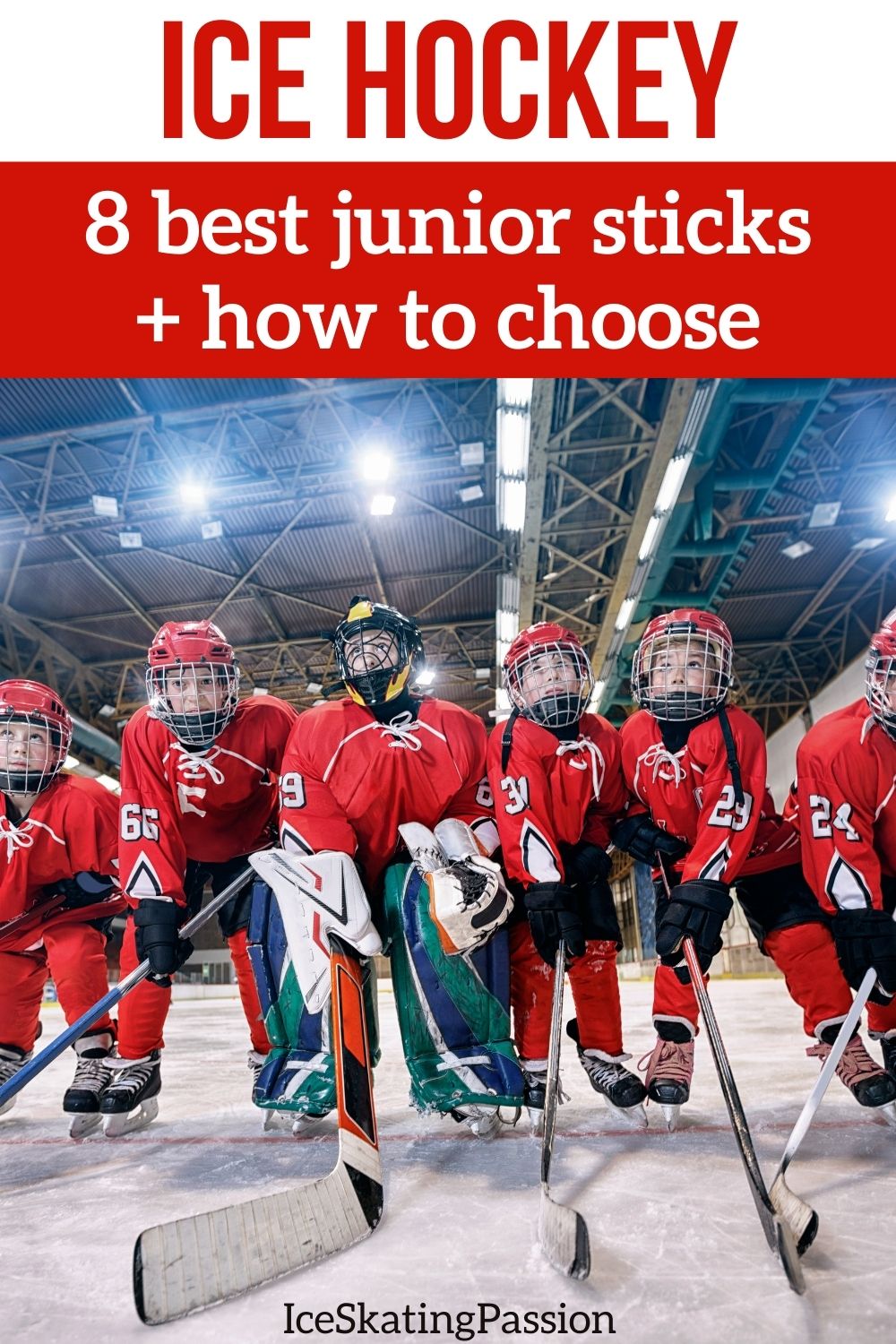
This article contains affiliate links. If you purchase using my link, I get a commission at no extra cost to you (more info here).
Best junior hockey sticks - short answer
In the article below, I will enter into the details to help you choose the best junior hockey stick for your kid including:
- 10 Criteria to properly choose
- Reviews of the 8 best sticks
- 6 Tips to take care of the stick and make it last longer
- Answers to your FAQs
But if you don't want to read the whole article, here is an overview of my selection of the best sticks for young kids:
Cheaper junior hockey sticks for beginners
Mid-range hockey sticks for developing junior players
High-end sticks for serious junior hockey players
How to choose the best hockey stick for your junior hockey player
In this section, I will break down the many technical terms associated with a hockey stick. I will explain the importance of each of these terms and how you should consider each factor when buying a junior hockey stick.
Before proceeding with the technical factors, I will also help you understand the difference between youth vs junior hockey stick and whether you should switch from a youth hockey stick to a junior hockey stick.
When to switch to junior from youth
When kids are at the age limit between youth and junior, it can be difficult to decide which sticks to look at.
Below are the main criteria for you to consider when taking the decision:
The diameter of the shaft is slightly larger for junior - if your kids has large hand, it may be time to switch to junior!
But don't buy junior too early as he/she will have a bad grip.
Other pros of switching to junior (see criteria detailed below):
- Options of curves
- Some options in the flex
- More choices of technology
- Higher quality products
This allow you to find a stick that can match the style of play of your kid.
Learn more in my article about Youth vs Junior hockey sticks.
Criteria 1 - Size & Length
When buying a hockey stick, the primary consideration must be that of the size and length of the hockey stick. For the same, you should note the following:
Size is based on age-wise classification, and length is the actual height of the stick. Greater reliance must be placed on the length of the hockey stick, while the size-based classification must only be used as a guideline.
Hockey sticks come in three lengths:
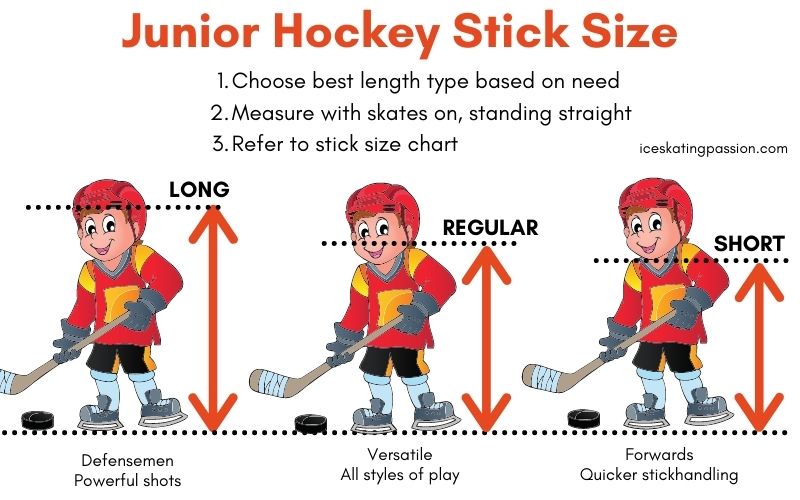
- Short: A short stick stays under the chin when wearing hockey skates. It is ideal for forwards, quicker stickhandling, and getting out of tricky situations close to the net.
- Regular: A regular hockey stick stays just under the nose when wearing hockey skates. It is ideal for all-round shot-making and suits most styles of play.
- Long: A long hockey stick comes above the nose when wearing hockey skates. This length suits defensemen and taller hockey players as it provides better reach. It also aids powerful shotmaking.
The length of the stick also determines the flex of the shaft. A shorter stick is stiffer than a longer stick. (More on hockey shaft flex below).
If your kid is a beginner, measure from the ground to the bottom of the chin with skates on, and pick the size that correspond.
Criteria 2 - Weight – Is lighter better?
Before determining if you should opt for a heavy stick or a lighter stick, you should first assess your level of experience in hockey.
Beginners: Regular stick that weighs in the mid-range weight to
- To support all-round development
- To help discover a unique style of play
- To assist in learning and playing a wide range of shots
- To prevent fatigue
The thumb rule here is not to overthink the weight of the stick until you make substantial progress in your hockey playing skills.
Advanced: Light or heavy stick depending on the style of play.
Once you’re sure about your style of play and your position in the team, you can consider the pros and cons of lighter as well as heavier sticks.
Lighter sticks:
- require lesser energy and thus cause lesser fatigue.
- allow quicker movements
- support intense stick-handling
- suit competitive games
- are less durable
Heavier sticks:
- suit strong players
- support powerful shotmaking
- work better for blocking and defense
- requires more energy and can cause fatigue
- are more durable
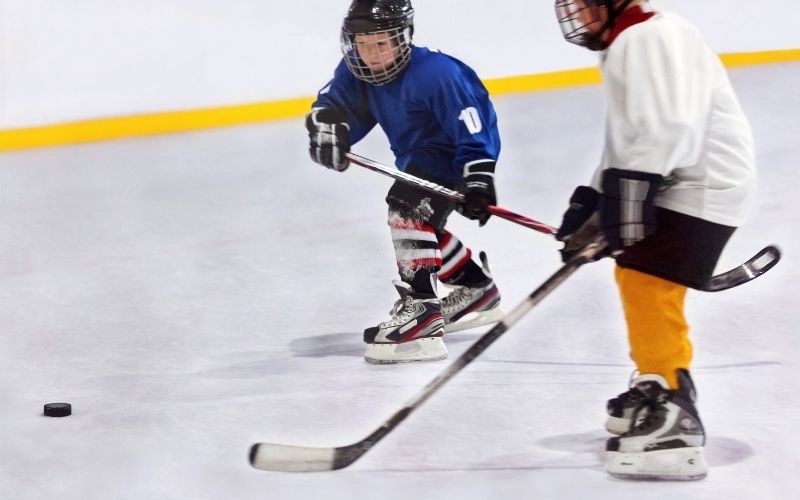
Criteria 3 - One-piece vs. two-piece construction
Hockey sticks come in two types of construction:
One-piece construction: A one-piece construction is where the blade and shaft are not two different pieces joined together. The entire hockey stick works as a single unit. One-piece construction has the following characteristics:
- It is lighter in weight
- It gives a consistent uniform feel of the stick
- It allows swifter stick handling & quicker shotmaking
- It conserves energy
- It requires the replacement of the entire stick in case of any damage to the shaft or blade.
- It is less customizable.
Two-piece construction: A two-piece construction is where a shaft and blade are two separate units put together to work as a hockey stick. The key characteristics of a two-piece construction are:
- It allows more customizations (e.g., you can opt for a classic wooden shaft and a composite blade)
- In case of damage, the entire stick need not be replaced.
- It is usually not as lightweight as a one-piece construction.
- Using a two-piece stick could require more energy than a one-piece stick.
Most players opt for a one-piece construction due to its stick-feel and lightweight.
But if you’re someone for whom standard one-piece sticks don’t work and want your stick to be more customizable, you could opt for a two-piece construction.
Criteria 4 - Flex of the shaft
Flex of the shaft refers to the weight that must be exerted on the shaft to make it bend to its full capacity. Getting the flex right is crucial to ensure high efficiency while playing ice hockey.
Flex makes the hockey stick work like a spring. Flex-rating of a stick determines:
- Amount of energy stored in the stick
- Speed of energy transfer from the stick to the puck
- Accuracy of the shot
So what flex-rating should you opt for?
Beginners: Do not overthink the flex rating at all. Go with a regular flex, i.e., half your body weight in pounds.
Forwards/Wristy players/ Players who hit many snapshots: Flex rating lower than half your body weight in pounds.
Defensemen/Power hitters/ Players who hit many slap shots: Flex rating higher than half your body weight.

Criteria 5 - Curve / blade pattern
The blade of a hockey stick comes in several variations based on differences in:
Curve Type: A blade can curve in one of the three areas
- Heel: the back of the blade where it meets the shaft
- Mid: Middle of the blade
- Toe: Front end of the blade that makes contact with the puck
Curve Depth: A blade can come in three types of curve depth variations - deep, medium, and shallow.
Curve length: A blade can be either relatively short or long.
Face angle: A blade comes in two key face angles -
- Open An angle where the blade faces away from the puck for lifting or high shots.
- Closed: An angle where the blade covers the puck or closes on the puck. It is excellent for better puck control, stickhandling and passing.
Lie: Lie is the angle between the blade and the shaft. A number between 3 and 8 denotes it.
- Lower lie: It works well for players who play in a crouched or stooped posture. It keeps the puck closer to the body.
- Higher lie: It works well for players who stand more upright while playing. It keeps the puck farther from the body.
As with every other technical aspect, a mid-variant often works the best for all-round shot-making. However, if you want a blade that works specifically for your style of play, please read the section on the style of play below.
Criteria 6 - Material
Hockey sticks are made using composite materials (a blend of carbon, fiber, aluminum, etc.) or pure wood.
To be perfectly honest, wooden hockey sticks are slowly becoming less and less popular as composite sticks are completely dominating the market.
Key benefits of a composite stick
- More durable
- Lighter
- Supports competitive levels of play
Key benefits of a wooden stick:
- Excellent stick-feel
- Affordable
- Better control over the puck
For junior players, though, I would recommend buying a composite stick as it performs well in all areas associated with ice hockey - right from learning the basics to playing advanced games.
Criteria 7 - Left-handed vs right-handed
The standard rule followed by most ice hockey players is that the player’s dominant hand stays on top of the stick. So based on this assumption-
- Left-handed players should use a hockey stick whose blade curves to the right when looking down the shaft.
- Right-handed players should use a hockey stick whose blade curves to the left when looking down the shaft.
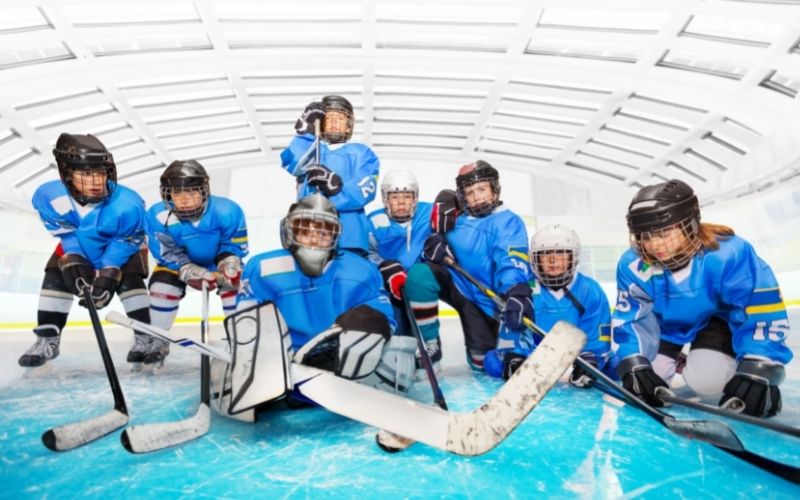
Criteria 8 - Price
The price of junior hockey sticks can be broadly classified as below:
- Budget: USD 50-100
- Mid Range: USD 100- 180
- Expensive: USD 180 and above
- Wooden hockey sticks are available for prices ranging between USD 20-50.
In most circumstances, a hockey stick in the expensive range will be better than a budget hockey stick. However, you should only opt for an expensive hockey stick once your child displays an advanced level of play.
Criteria 9 - Style of Play / Preferred position
As can be seen from the above technical details, hockey sticks are made using different materials, flex, blade types, and curves.
Choosing a hockey stick that works for your style of play and is complementary to your playing position is critical to sustaining competitive levels of play.
For junior, you can start seeing where strengths and preferences are for a player. Therefore you can choose a stick for that position.
Below are a few broad examples of what technical aspects work for what style of play and playing position.
Forwards / Quick shot-making / Wristy play:
- Short stick
- Lower flex
- Mid/Toe curve
- Open-angle
- Lower lie
- Shorter blade
Defensemen / Powerful hitting / Longer loading time:
- Long stick
- Higher flex
- Mid/Heel curve
- Closed-angle
- Higher lie
- Longer blade
Please note that the above specifications are only suggested to be used as broad guidelines. You may have to make alterations based on your physique, height, unique shot-making style, and skill level.
Criteria 10 - Brand
The key brands manufacturing hockey sticks are Bauer, CCM, Warrior, True, and Sherwood make excellent composite hockey sticks. In fact, Bauer, CCM, and Sherwood also make great wooden hockey sticks.
It is better to opt for sticks made by these renowned brands only as they are made using advanced technology developed particularly for ice hockey.Cheaper Junior hockey sticks for beginners - Reviews
Bauer Vapor X2.7
Weight: 412 grams
Material: UD Carbon Fiber
Pros:
- Lightweight for this price range
- Ideal stick for quick-paced game and snapshots
- Excellent puck feel
- Durable
Cons:
- Not suitable for shots requiring higher load time
- Experienced players will have to upgrade to the higher variant
This stick is an excellent budget-range choice for players that like to play competitive matches. In particular, the Bauer Vapor X2.7 is geared towards faster shot-making.
To allow this, Bauer uses its quick-release technology at a lower kick point that works efficiently at releasing the puck quickly. For the shaft, it uses carbon fiber material. The carbon fiber used in hockey sticks ensures a seamless energy transfer between the handle and the blade. The carbon fiber blade further transfers that energy onto the puck quickly.
Moreover, the carbon fiber weave also makes this stick durable than other lightweight models. The feel of the stick is also great for taking on confident shot-making and controlled stickhandling.
Thus, as a new hockey player, who mostly stays close to the net and likes a balance of powerful and quick shot-making, this stick is an excellent choice for this budget.
Bauer Nexus N37
Weight: 460 grams
Material: UD Carbon Fiber
Pros:
- Ideal weight for quick release and powerful shot
- Budget-friendly stick for competitive play
- Supports all-round shotmaking
- Durable
Cons:
- Advanced players will need to upgrade
The Bauer Nexus N37 is a classic Nexus design by Bauer which supports all-round playing. Thanks to its mid-kick point, it delivers fast snapshots as well as shots requiring a longer load time. The extra weight on this stick also helps with added power.
However, this does not mean that the stick falls short in its ability to hit impactful snapshots. The blade profile that comes in Bauer sticks is lightweight. It is capable of releasing the puck quickly off the stick.
Thus, overall, this stick is a fantastic stick for junior players who want an all-round value for money stick to grow along with their growth in play.
However, do note that once you develop a specific playing style, you may have to look for a stick that complements it instead of relying on this stick.
CCM Jetspeed 460
Weight: 368 grams
Material: Carbon Fiber
Pros:
- Most value-for-money hockey stick
- Shaft offers excellent grip and control
- Durable construction
- Lightweight
- Mid-kick-point for versatile shot-making
Cons:
- Not suitable for absolute beginners
The CCM Jetspeed 460 is an excellent stick made using impressive features all throughout to assist you no matter your playing style.
To begin with, the CCM Jetspeed uses the same shaft as its elite models. Thus, the shaft offers an excellent stick feel and a reliable grip. You don’t have to worry about your hands shifting during play when using this stick.
Furthermore, the hybrid flex is designed to offer quickness for your snapshots and extra loading for your full-motion shots. This versatility also extends to its carbon fiber weave blade. The blade’s stiffness improves power while its low weight allows a quick energy transfer to the puck.
The use of this JS3 blade also improves the puck-feel. Your accuracy is guaranteed to increase when using this carbon fiber stick.
Overall, the Jetspeed CCM is an excellent choice for junior-level players serious about taking their game to the next level.
Mid-range best ice hockey junior sticks for developing players
Warrior Covert QRE 30
Weight: 465 grams
Material: Minimus 900D Carbon Fiber
Pros:
- Excellent puck feel
- Selectively placed grip for better stickhandling
- Durable stick
- Taper technology for power-punched quick motion shots
Cons:
- Not exactly the best junior hockey stick for defenseman
The Warrior Covert QRE is an excellent stick for those ready to upgrade from their first stick.
This junior hockey stick cleverly packs high-quality material to enhance power in shots without costing you any extra load time. This impressive balance is achieved by its uniquely designed tapering angle coupled with its sturdy Minimus Carbon 900D shaft.
The tapering angle added to a solid carbon composite stick helps load the stick much faster with energy required for making snapshots feel power-punched. The energy transfer to the puck also takes a fraction of a second.
For its low kick point, the stick’s capacity to load energy for long-motion shots is also impressive.
In terms of the grip, too, the strategically placed texture makes stickhandling feel less cumbersome.
The highlight of this stick is its blade construction. Unlike most other lightweight blades in this price range that get damaged easily, this blade can last much longer. To increase its durability, the blade has reinforced its core. Not only does this help with added durability but also improves puck-feel considerably.
Overall, the quality of material used in this stick improves the overall stick feel considerably (especially compared to budget-range sticks) and allows players to take on the game more confidently.
Warrior Alpha DX Pro
Weight: 338 grams
Material: Minimus Carbon 1000
Pros:
- High-quality stick designed for all-round shots
- Strong & lightweight shaft
- Impressive stick-feel to boost stickhandling confidence
- Capable of complementing the development of skills
- Provides great value for money
Cons:
- Not suitable for absolute beginners
The Warrior Alpha DX Pro is an absolute value-for-money stick for those that want a highly sophisticated lightweight construction without spending extra money on top-of-the-line sticks.
The stick uses a mid-kick point intensified for better delivery using a sturdy Minimus Carbon 1000 shaft.
The one-piece construction backed with the same elite-level True 1 Phantom Feel technology provides a seamless energy transfer. Juniors will not have to lean heavily on this stick to generate punch in their shots.
The Ergo shaft shape and the tacky soft grip help young hands control the stick much better for passing and face-offs.
Warrior’s signature Fuelcore technology, used in Warrior Covert QRE, is also used on the Alpha DX. The improved puck feel delivered by this technology advances accuracy and gives more pop to the shots. Thus for a lightweight construction, the blade feels ultra-sturdy.
To round up, this is an ideal hockey stick for a junior who practices regularly, plays league matches, and is looking for a reliable stick to support his/her growth.
Sher-wood Rekker M90
Weight: 305 grams
Material: Blackline XXV
Pros:
- Lightweight
- Best junior hockey stick for forwards
- Durable
- Excellent shot-release speed
Cons:
- Not suitable for shots requiring a longer load time/defensemen
There are very few junior hockey sticks made in this price range that are specifically engineered to assist forwards.
The Sher-wood Rekker M90 is one such stick. It is designed specifically for a low-kick point style of play. Accordingly, the technology is geared towards improving the speed of the shot release. For this, the makers have used a tapered design for a super-fast release. The stick, effortlessly, delivers the speed required to get out of tight spots playing close to the net.
The high puck-feel offered by this thin blade also boosts the confidence required for taking shots at the net.
The ultra-lightweight of the stick also facilitates speedy shots. However, for a stick that is so light, the use of carbon fiber in the shaft makes the stick feel strong. The impacts of shots are quickly neutralized. Overall, the stick is also considerably more durable than other lightweight sticks.
Finally, opt for this Sher-wood stick if your kid is a forward in the team and wants a stick for high-speed shots.
High-end junior hockey sticks for serious players
True project X grip
Weight: 290 grams
Material: Precision Laminate Design
Pros:
- Provides great value for money
- Excellent construction for a low-kick point
- Lightweight
- Great puck feel for better accuracy and speed
- Easily supports elite-level hockey players
Cons:
- Only suitable for forwards
Not very durable
The True Project X Stick uses high-end technology and engineering to deliver a stick that’s truly capable of handling an elite level of play.
The shaft of the stick uses a double concave design. This makes holding the stick feel natural and keeps the hands secure when receiving passes. The lightweight construction helps with quick snapshots and wrist shots as well.
For being the lightest junior hockey stick, the power that its shots generate impresses. The low-kick point allows for maximum energy loading and efficient transfer to the blade. The puck-feel offered by the blade will let junior players shoot for the net with absolute conviction.
Every element on this stick unites to work as a single cohesive unit which greatly improves control, accuracy, and speed on the shots.
Overall, if you are willing to consider a brand other than Bauer or CCM, Project X by True is a fantastic choice for pro-level junior players.
Bauer Nexus Geo Grip 50 flex
Weight: 380 grams
Material: Asymmetrical TeXtreme Carbon & DuraFlex Resin System
Pros:
- One of the best sticks in the market for versatile shot-making
- High-quality construction
- Optimized for speed and power
- Tailored for elite-level playing
- Durable
Cons:
- Slightly expensive
The Bauer Nexus Geo is one of the finest junior sticks in the market. Every element on this stick is thoughtfully engineered and impresses when put to use.
The shaft of the stick uses a 5-sided design that fits perfectly in the hands of a junior. The design itself improves stickhandling considerably. To add to this, the shaft uses Bauer’s popular Duraflex resin, which makes the shaft feel sturdy and flexible for versatile shot-making.
The easy flex cuts down effort and speed massively, useful for playing at elite levels. Thus the sturdiness of the Duraflex shaft complements both faster-releasing snapshots as well as longer loading slapshots.
The blade renders an excellent puck-feel that improves control and accuracy while passing and shooting.
Overall, Bauer has blended an impressive ER Spine, a strong Duraflex resin construction, and the Asymmetrical TeXtreme finish to make a stick that is guaranteed to generate better performance from the player.
6 Tips to take care of a junior hockey stick to make it last longer
Hockey sticks are susceptible to damage and need to be replaced frequently on account of the growing height and age of junior kids.
Thus expenditure on hockey sticks can often start to feel like a burden. This is precisely why it is critical to take care of the hockey stick diligently. You must train your child to take proper care of hockey equipment and build habits that promote due care of hockey gear.
To increase the life of your junior hockey stick, follow the tips given below:
Tip 1 - Taping the stick:
Taping the stick protects the blade from damages and also from deterioration on account of moisture build-up.
Ideally, you must tape your child’s stick immediately after you buy it and then whenever you notice wear & tear of the tape. Thus, depending on the frequency and level of play, you may have to retape the stick every couple of games or once a month!
Taping must be done on the blade, on the shaft as well as on the butt.
Taping must be done in evenly overlapping wraps. Moreover, for the shaft, the tape must be rolled into a rope to create a grip. For the butt, the tape must be wrapped over multiple times to create a knob.
Tip 2 - Carrying the stick:
To prevent any damage during storage and commute, the stick must be stored and carried around in a hockey stick bag.
Tip 3 - Drying the stick:
The stick is constantly in contact with ice and hence runs the risk of moisture build-up. To prevent any damage on account of moisture, the stick must be dried out completely after every use.
To dry the stick, take it out of the bag and place it on a rack in a normal temperature room. Ideally, you should dry out all your hockey equipment on a wall mount hockey equipment drying rack easily available on Amazon.
Tip 4 - Wrapping the stick
If you intend to use the stick on surfaces other than ice, you must, at all costs, wrap the stick using a ‘hockey wrap around ice’ to protect the blade.
Tip 5 - Inspecting the stick:
Inspecting the stick regularly for chips, cracks, or the development of small holes can prevent serious damage and breaking of the stick.
If you notice any chips, cracks, or small holes, fill them up with epoxy resin glue.
For wooden sticks, make sure you remove splinters immediately when they start appearing and retape the area for protection.
Tip 6 - Personalizing the stick:
Always write initials on the hockey stick to personalize it for easy identification.
Doing this avoids mix-ups and saves you the unnecessary expenditure of buying a new hockey stick.
Best junior hockey sticks - FAQs
How often do you replace a stick? When should you replace a stick?
Hockey sticks must be replaced when
- The stick breaks or
- The height/weight of your child changes substantially.
Repairing a broken hockey stick completely changes the inherent configuration structure of the stick and makes it unsuitable for play.
However, a stick need not be replaced in case of:
- Minor cracks
- Minor Chips
- Development of small holes
All of the above damages to the hockey stick can be fixed, provided the same are detected at a very early stage.
Thus, there is no standard rule that applies to replacing a hockey stick, and a decision to replace a stick must be made based on a case-to-case basis.
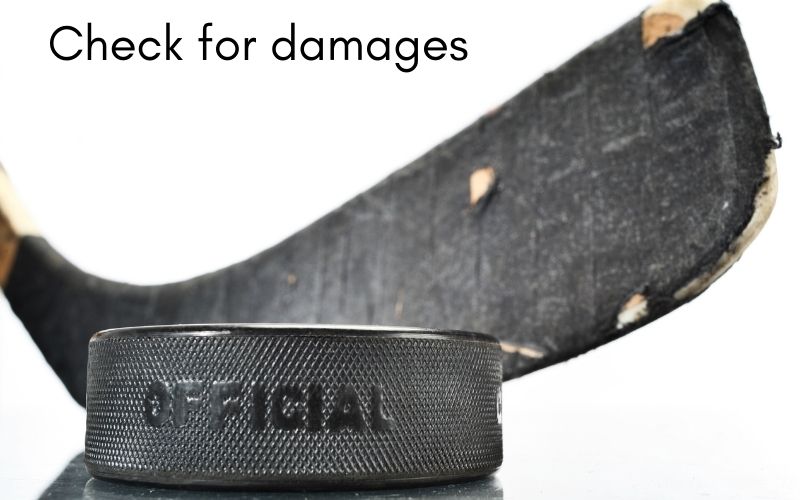
Are expensive sticks worth it for juniors? How much should I put into my child’s hockey stick? (Growth, difficulty of play)
For Junior players that have shown great advancement in skills and technique, investing in an expensive stick is absolutely worth it. This is because an expensive stick is crafted to deliver efficient puck control, grip, stickhandling, and shot-making.
Expensive sticks also come in various specifications that can further refine the stick’s compatibility with the player’s style and technique.
However, expensive sticks will not suit a junior player who is still learning ice hockey basics. In such a case, it is best to buy a budget or a mid-range hockey stick.
Complete your kid's hockey equipment set!
- Best hockey gloves for players - read article
- Best hockey helmets - read article
- Best hockey laces - read article
- Best hockey mouthguard - read article
- And check out my 30+ tips for hockey moms - read article
